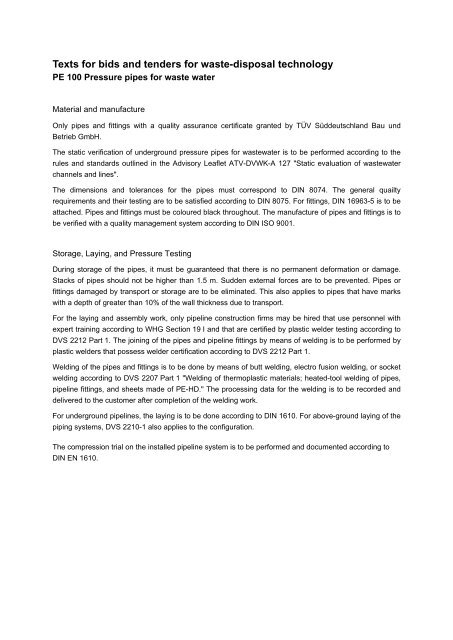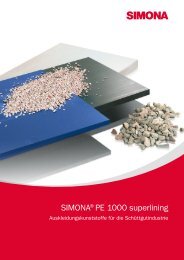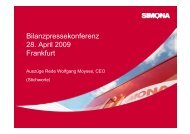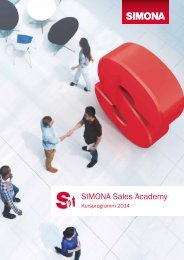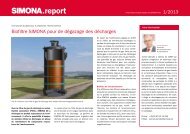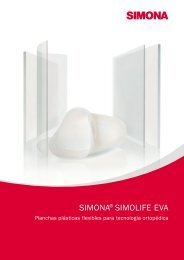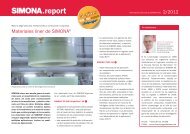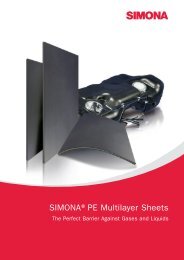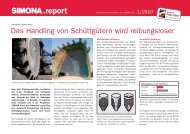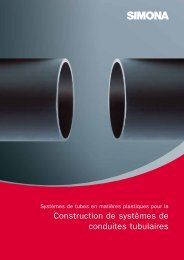Texts for bids and tenders for waste-disposal technology
Texts for bids and tenders for waste-disposal technology
Texts for bids and tenders for waste-disposal technology
You also want an ePaper? Increase the reach of your titles
YUMPU automatically turns print PDFs into web optimized ePapers that Google loves.
<strong>Texts</strong> <strong>for</strong> <strong>bids</strong> <strong>and</strong> <strong>tenders</strong> <strong>for</strong> <strong>waste</strong>-<strong>disposal</strong> <strong>technology</strong><br />
PE 100 Pressure pipes <strong>for</strong> <strong>waste</strong> water<br />
Material <strong>and</strong> manufacture<br />
Only pipes <strong>and</strong> fittings with a quality assurance certificate granted by TÜV Süddeutschl<strong>and</strong> Bau und<br />
Betrieb GmbH.<br />
The static verification of underground pressure pipes <strong>for</strong> <strong>waste</strong>water is to be per<strong>for</strong>med according to the<br />
rules <strong>and</strong> st<strong>and</strong>ards outlined in the Advisory Leaflet ATV-DVWK-A 127 "Static evaluation of <strong>waste</strong>water<br />
channels <strong>and</strong> lines".<br />
The dimensions <strong>and</strong> tolerances <strong>for</strong> the pipes must correspond to DIN 8074. The general quailty<br />
requirements <strong>and</strong> their testing are to be satisfied according to DIN 8075. For fittings, DIN 16963-5 is to be<br />
attached. Pipes <strong>and</strong> fittings must be coloured black throughout. The manufacture of pipes <strong>and</strong> fittings is to<br />
be verified with a quality management system according to DIN ISO 9001.<br />
Storage, Laying, <strong>and</strong> Pressure Testing<br />
During storage of the pipes, it must be guaranteed that there is no permanent de<strong>for</strong>mation or damage.<br />
Stacks of pipes should not be higher than 1.5 m. Sudden external <strong>for</strong>ces are to be prevented. Pipes or<br />
fittings damaged by transport or storage are to be eliminated. This also applies to pipes that have marks<br />
with a depth of greater than 10% of the wall thickness due to transport.<br />
For the laying <strong>and</strong> assembly work, only pipeline construction firms may be hired that use personnel with<br />
expert training according to WHG Section 19 I <strong>and</strong> that are certified by plastic welder testing according to<br />
DVS 2212 Part 1. The joining of the pipes <strong>and</strong> pipeline fittings by means of welding is to be per<strong>for</strong>med by<br />
plastic welders that possess welder certification according to DVS 2212 Part 1.<br />
Welding of the pipes <strong>and</strong> fittings is to be done by means of butt welding, electro fusion welding, or socket<br />
welding according to DVS 2207 Part 1 "Welding of thermoplastic materials; heated-tool welding of pipes,<br />
pipeline fittings, <strong>and</strong> sheets made of PE-HD." The processing data <strong>for</strong> the welding is to be recorded <strong>and</strong><br />
delivered to the customer after completion of the welding work.<br />
For underground pipelines, the laying is to be done according to DIN 1610. For above-ground laying of the<br />
piping systems, DVS 2210-1 also applies to the configuration.<br />
The compression trial on the installed pipeline system is to be per<strong>for</strong>med <strong>and</strong> documented according to<br />
DIN EN 1610.
<strong>Texts</strong> <strong>for</strong> <strong>bids</strong> <strong>and</strong> <strong>tenders</strong> <strong>for</strong> <strong>waste</strong>-<strong>disposal</strong> <strong>technology</strong><br />
PE 80 Pressure pipes <strong>for</strong> <strong>waste</strong> water<br />
Material <strong>and</strong> Manufacture<br />
Only pipes <strong>and</strong> fittings with a quality assurance certificate granted by TÜV Süddeutschl<strong>and</strong> Bau <strong>and</strong><br />
Betrieb may be used.<br />
Static verification of underground pressure pipes <strong>for</strong> <strong>waste</strong>water is to be done according to the rules <strong>and</strong><br />
st<strong>and</strong>ards outlined in the Advisory Leaflet ATV-DVWK-A 127 "Static evaluation of <strong>waste</strong>water channels<br />
<strong>and</strong> lines".<br />
The dimensions <strong>and</strong> tolerances <strong>for</strong> the pipes must correspond to DIN 8074. The general quality<br />
requirements <strong>and</strong> their testing is to be satisfied according to DIN 8075. For fittings, DIN 16963-5 is to be<br />
attached. Pipes <strong>and</strong> fittings must be coloured black throughout.<br />
The manufacture of the pipes <strong>and</strong> fittings is to be verified with a quality management system according to<br />
DIN ISO 9001.<br />
Storage, Laying, <strong>and</strong> Pressure Testing<br />
During storage, it must be guaranteed that there is no permanent de<strong>for</strong>mation or damage. Stacks of pipes<br />
should not be higher than 1.5 m. Sudden external <strong>for</strong>ces are to be prevented. Pipes or fittings damaged by<br />
transport or storage are to be eliminated. This also applies to pipes that have marks with a depth of<br />
greater than 10% of the wall thickness due to transport.<br />
For the laying <strong>and</strong> assembly work, only pipeline construction firms may be hired that use personnel with<br />
expert training according to WHG Section 19 l. The joining of pipes <strong>and</strong> pipeline fittings is to be per<strong>for</strong>med<br />
by plastic welders that have welder certification according to DVS 2212 Part 1.<br />
The welding by means of heated-tool butt welding <strong>and</strong> electro fusion welding is to be per<strong>for</strong>med according<br />
to DVS 2207 Part 1 "Welding of thermoplastic materials; heated-tool welding of pipes, pipeline fittings, <strong>and</strong><br />
sheets made of HDPE." The processing data <strong>for</strong> the welding is to be recorded <strong>and</strong> delivered to the<br />
customer after completion of the welding work.<br />
The laying is to be per<strong>for</strong>med according to DIN EN 1610 "Laying <strong>and</strong> testing of <strong>waste</strong>water lines <strong>and</strong><br />
channels." In addition, the instructions of the Advisory Leaflets ATV-DVWK-A 127 "Static evaluation of<br />
<strong>waste</strong>water channels <strong>and</strong> lines," ATV-A 139 "Laying <strong>and</strong> testing of <strong>waste</strong>water channels <strong>and</strong> lines" <strong>and</strong><br />
the laying instructions A 735 of the Kunststoffrohrverb<strong>and</strong> (Association of plastic piping) are to be<br />
followed.<br />
The compression trial on the piping system is to be per<strong>for</strong>med according to DIN EN 1610.
<strong>Texts</strong> <strong>for</strong> <strong>bids</strong> <strong>and</strong> <strong>tenders</strong> <strong>for</strong> <strong>waste</strong>-<strong>disposal</strong> <strong>technology</strong><br />
PE 100 SPC-Waste water pressure pipes/PE 80 SPC-Waste water pipes<br />
Material <strong>and</strong> Manufacture<br />
SIMONA SPC-Waste water pipes can be used as <strong>waste</strong> water pressure pipes <strong>and</strong> <strong>waste</strong> water channel<br />
pipes. The pipes correspond to the quality requirements of DIN 8074/75 <strong>and</strong> TÜV Süddeutschl<strong>and</strong>. In<br />
addition, DIN 19537 <strong>and</strong> TÜV Süddeutschl<strong>and</strong> applies to the field of <strong>waste</strong>water channel pipes.<br />
Manufacturing is per<strong>for</strong>med in a continuous production process by means of a coextrusion procedure. The<br />
protective jacket that is mounted on the tool-side on the inner pipe <strong>and</strong> that is made of modified<br />
polypropylene is used as protection from external material damage of the inner pipe during laying <strong>and</strong><br />
while the pipe is in service. The axial shear strength between inner pipe <strong>and</strong> protective jacket is<br />
N/mm 2<br />
(testing according to DIN 53769). The quality is guaranteed according to the rules of DIN EN ISO<br />
9001. Quality verification according to DIN EN 10204, acceptance test certification 3.1.<br />
Storage, Processing <strong>and</strong> Laying<br />
Laying is done according to the instructions of the corresponding KRV laying guidelines, as well as<br />
manufacturer instructions. Processing is to be per<strong>for</strong>med according to currently valid technical regulations<br />
<strong>for</strong> pipeline construction, e.g., DVS guideline DVS-2207-1 (Welding of thermoplastic materials) or DVS-<br />
2208-1 (Machines), as well as appropriate st<strong>and</strong>ards. Laying is done according to DIN EN 1610, KRV<br />
laying instructions, as well as corresponding DVGW guidelines <strong>and</strong> corresponding manufacturer<br />
instructions.<br />
3.0
<strong>Texts</strong> <strong>for</strong> <strong>bids</strong> <strong>and</strong> <strong>tenders</strong> <strong>for</strong> <strong>waste</strong>-<strong>disposal</strong> <strong>technology</strong><br />
PE 80 Sewer pipes<br />
SIMONA<br />
PE 80 pipes may be welded to SIMONA<br />
PE 100 fittings. Within this context, the general<br />
welding guideline DVS 2207 must be observed. It is also possible to combine fittings made of PE 100 with<br />
pipes from the same SDR series made of PE 80, following the above mentioned guidelines.<br />
Consequently, <strong>for</strong> system planning purposes <strong>and</strong> the sizing of SIMONA<br />
to use the entire range of SIMONA<br />
Material <strong>and</strong> manufacture<br />
PE 80/100 fittings.<br />
PE 80 sewer pipes it is possible<br />
Only pipes <strong>and</strong> fittings with a quality assurance certificate granted by TÜV Süddeutschl<strong>and</strong> Bau <strong>and</strong><br />
Betrieb GmbH may be used.<br />
Manufacture with proof of quality assurance to DIN EN ISO 9001.<br />
Storage <strong>and</strong> laying<br />
In storage care must be taken to ensure that no permanent de<strong>for</strong>mities or damage occur. Stacks of pipes<br />
should not be higher than 1.5 m <strong>and</strong> must be secured at the sides. Sudden stress must be avoided. Pipes<br />
<strong>and</strong> fittings damaged in transit or storage must be segregated so that they can no longer be used. This<br />
also applies to pipes which have scores caused in transit with a depth of over 10% of wall thickness.<br />
Watertight <strong>and</strong> longitudinally positive pipe connection by heating element butt welding or electro fusion<br />
welding to DVS Guideline In<strong>for</strong>mation Sheet 2207.<br />
When making connections to shafts <strong>and</strong> structures, the thermal expansion usually applicable to plastics<br />
must be taken into consideration. If necessary, the pipe ends to be connected should be temporarily<br />
immobilised with earth fills.<br />
As is generally the case in sewer construction, supporting <strong>and</strong> embedding pipes <strong>and</strong> fittings is crucial to<br />
the stability of the pipeline. Special attention must there<strong>for</strong>e be paid to the embedding work in accordance<br />
with the structural analysis. Compacting must be per<strong>for</strong>med in layers. Where the ground is rocky or stony,<br />
the bottom of the trench must be dug at least 0.15 m deeper. In accordance with the construction<br />
drawings, the sewer pipeline is to be laid <strong>and</strong> aligned on a continuously stone-free, compactable s<strong>and</strong> fill<br />
at final elevation (alternatively, twice crushed <strong>and</strong> screened chippings 2/5 mm to stabilise the pipe zone<br />
are allowed in the groundwater area). Material replacement <strong>for</strong> pipe support <strong>and</strong> pipe bed will be paid <strong>for</strong><br />
separately. Pressure test in accordance with DIN EN 1610. Proof of load capability/sizing of pipe wall<br />
thickness depending on the placement conditions in accordance with Structural Analysis Guideline ATV-<br />
DVWK A-127:
<strong>Texts</strong> <strong>for</strong> <strong>bids</strong> <strong>and</strong> <strong>tenders</strong> <strong>for</strong> <strong>waste</strong>-<strong>disposal</strong> <strong>technology</strong><br />
PP-H 100 Sewer pipes<br />
Application note<br />
SIMONA<br />
PP-H 100 pipes may be welded to SIMONA<br />
PP-R 80 fittings. Within this context, the general<br />
welding guideline DVS 2207 must be observed. It is also possible to combine fittings made of PP-R 80<br />
with pipes from the same SDR series made of PP-H 100, following the above mentioned guidelines.<br />
Consequently, <strong>for</strong> system planning purposes <strong>and</strong> the sizing of SIMONA<br />
possible to use the entire range of SIMONA<br />
Material <strong>and</strong> manufacture<br />
PP fittings.<br />
PP-H 100 sewer pipes it is<br />
Industrial sewer made of pipes of the service class PP-H 100 acc. to DIN 8077/78, including PP fittings to<br />
DIN 16962, as an open channel <strong>for</strong> non-pressurised operation. For maximum chemical resistance with<br />
low-stress pipe manufacture due to thermal after-treatment. Suitable <strong>for</strong> effluent temperatures up to 80°C<br />
with admission peaks above 100°C.<br />
Manufacture with proof of quality assurance to DIN EN ISO 9001.<br />
Storage <strong>and</strong> laying<br />
In storage care must be taken to ensure that no permanent de<strong>for</strong>mities or damage occur. If the pipes <strong>and</strong><br />
fittings are to be stored outdoors <strong>for</strong> a lengthy period they must be protected against solar radiation.<br />
Stacks of pipes should not be higher than 2 m <strong>and</strong> must be secured at the sides. Sudden stress must be<br />
avoided. This particularly applies at low temperatures. Pipes <strong>and</strong> fittings damaged in transit or storage<br />
must be segregated so that they can no longer be used. This also applies to pipes which have scores<br />
caused in transit with a depth of over 10% of wall thickness.<br />
Watertight <strong>and</strong> longitudinally positive pipe connection by heating element butt welding or electro fusion<br />
welding to DVS Guideline In<strong>for</strong>mation Sheet 2207.<br />
When making connections to shafts <strong>and</strong> structures the thermal expansion usually applicable to plastics<br />
must be taken into consideration. If necessary the pipe ends to be connected should be temporarily<br />
immobilised with earth fills.<br />
As is generally the case in sewer construction, supporting <strong>and</strong> embedding the pipes <strong>and</strong> fittings is crucial<br />
to the stability of the pipeline. Special attention must there<strong>for</strong>e be paid to the embedding work in<br />
accordance with the structural analysis. Compacting must be per<strong>for</strong>med in layers. Where the ground is<br />
rocky or stony, the bottom of the trench must be dug at least 0.15 m deeper.<br />
In accordance with the construction drawings, the sewer pipeline is to be laid <strong>and</strong> aligned on a<br />
continuously stone-free, compactable s<strong>and</strong> fill at final elevation (alternatively, twice crushed <strong>and</strong> screened<br />
chippings 2/5 mm to stabilise the pipe zone are allowed in the groundwater area). Material replacement <strong>for</strong><br />
pipe support <strong>and</strong> pipe bed will be paid <strong>for</strong> separately.
Pressure test in accordance with DIN EN 1610.<br />
Proof of load capability/sizing of pipe wall thickness depending on the placement conditions in accordance<br />
with Structural Analysis Guideline ATV-DVWK A-127:


